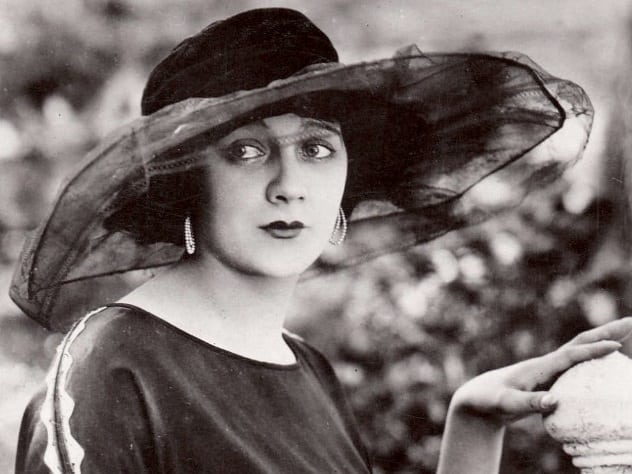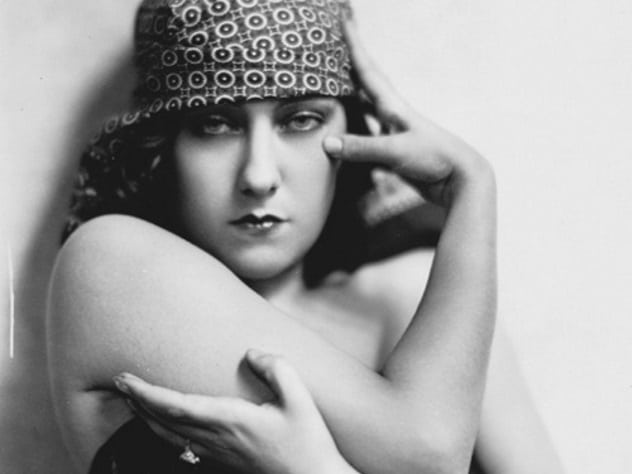 Movies and TV
Movies and TV  Movies and TV
Movies and TV  Creepy
Creepy 10 Eerie & Mysterious Ghosts of the Pacific Coast
 Weird Stuff
Weird Stuff 10 Typos That Accidentally Changed History
 History
History 10 Times Trickery Won Battles
 Technology
Technology 10 Awesome Upgrades to Common Household Items
 Misconceptions
Misconceptions 10 Hilarious (and Totally Wrong) Misconceptions About Childbirth
 Weird Stuff
Weird Stuff 10 Warning Labels That Exist Because Someone Actually Tried It
 Health
Health Ten Confounding New Inventions from the World of Biomedicine
 Creepy
Creepy 10 Death Superstitions That Will Give You the Creeps
 Movies and TV
Movies and TV 10 Movies That Get Elite Jobs Right, According to Experts
 Movies and TV
Movies and TV 10 Most Realistic Medical TV Shows of All Time
 Creepy
Creepy 10 Eerie & Mysterious Ghosts of the Pacific Coast
 Weird Stuff
Weird Stuff 10 Typos That Accidentally Changed History
Who's Behind Listverse?

Jamie Frater
Head Editor
Jamie founded Listverse due to an insatiable desire to share fascinating, obscure, and bizarre facts. He has been a guest speaker on numerous national radio and television stations and is a five time published author.
More About Us History
History 10 Times Trickery Won Battles
 Technology
Technology 10 Awesome Upgrades to Common Household Items
 Misconceptions
Misconceptions 10 Hilarious (and Totally Wrong) Misconceptions About Childbirth
 Weird Stuff
Weird Stuff 10 Warning Labels That Exist Because Someone Actually Tried It
 Health
Health Ten Confounding New Inventions from the World of Biomedicine
 Creepy
Creepy 10 Death Superstitions That Will Give You the Creeps
 Movies and TV
Movies and TV 10 Movies That Get Elite Jobs Right, According to Experts
10 Silent Movie Stars Too Scandalous For Words
Today, silent movies appear to have an old-timey innocence about them. Villains twirled mustaches, and damsels were always in distress but always rescued by a handsome hero at the last moment. Even the tramps seemed whimsical.
However, behind the camera, the burgeoning film industry was decadent and dissolute. Movie stars made fantastic amounts of money and spent it wildly, mostly, it seems, on drink and drugs. Studios tried hard to keep the scandals out of the press and present a wholesome family image, working their publicity departments at full stretch to not only promote the films but protect their stars.
Given the antics many of them got up to, it was a blessing that they couldn’t talk!
10 William Desmond Taylor

At the height of the silent era, William Desmond Taylor was riding high. A noted film director, he directed 60 films and acted in 27. But on February 1, 1922, he was murdered by an unknown assailant. The scandal that followed almost destroyed the fledgling movie industry.
Taylor had been shot in his home. There was no sign of a break-in, and cash was found on his body and in the house, which seemed to rule out a burglary gone wrong. There was a 12-hour delay in reporting the death, and when police arrived, they are said to have found studio bosses frantically burning Taylor’s papers.
Witnesses said that the movie star Mabel Normand had been with him that evening, and she was immediately suspected. A large number of rumors circulated about the lifestyle of both Taylor and Normand, including drug dealing, sexual perversion, and even Satanism.
The rumor mill was fueled by Taylor’s mysterious past, not least the fact that his name was not Taylor at all but William Cunningham Dean-Tanner, which is even more of a mouthful. The appearance of the wife and child whom he had deserted in 1908 added fuel to the fire.
There was a long list of suspects as well as 300 people who confessed to the murder despite appearing to have never met Taylor. Mabel Normand was among the chief suspects, and her career never really recovered.[1] Some strenuous attempts were made to implicate a former employee of Taylor’s, but no one was ever charged.
9 Barbara La Marr

Barbara La Marr was nicknamed the “girl who was too beautiful”—too beautiful for Hollywood and, it seemed, too beautiful to live. Her life was always colorful. She was at one time kidnapped by her own sister. A star of 27 silent films, such as The Three Musketeers and The Prisoner of Zenda, La Marr even co-wrote some of her movies.
Her public success was not mirrored in her private life, however. She was married at least four times and had a son whose existence she kept secret. She claimed to sleep for only two hours a night. Whether her rumored drug addiction or her bizarre dietary regimens contributed to her insomnia is unclear.
La Marr, despite her beauty, began to fall out of favor with the studios but continued to work regardless, desperate to regain her popularity. Even a terminal lung condition could not prevent her from working. Finally, one day, she collapsed on set. She died a few months later at the age of 29.[2]
8 Charlie Chaplin

Probably the most famous star of the silent era, Charlie Chaplin is still adored by many today. His Tramp character is one of the most enduring in Hollywood history. His success brought him the kind of wealth he could only have dreamed of during his poverty-stricken childhood. He had a mind for business and set up his own studio, increasing both his profits and his artistic freedom.
Privately, however, Chaplin’s life was much more complicated. He was married several times and was the defendant in a paternity suit. He even bribed a doctor (to the tune of $25,000) to make false entries on the birth certificate of one of his children. More damningly, he is known to have had numerous relationships with women under the age of consent.
Chaplin was denounced as a Communist by the House Un-American Activities committee in 1947, and his star began to dwindle. After a trip to London, his reentry permit was revoked. Knowing that he would have to explain his political views and private life, Chaplin chose not to return and moved to Switzerland. It was a sad end to an illustrious career.[3]
7 Olive Thomas

Olive Thomas began her career as an artist’s model and then as a dancer. She won her first movie contract in 1916 and soon met and married the actor Jack Pickford. The couple seemed to have a glamorous life, though there were signs that, perhaps due to long work-induced separations, things were not going well.[4]
In September 1920, the two went on a second honeymoon to Paris. They are said to have enjoyed a night of high revelry at some of Paris’s more notorious night spots. On returning to their suite at the Ritz, Thomas, for reasons unknown, swallowed a bottle of Pickford’s medicine. It was mercury bichloride, a toxic medication prescribed to Pickford to treat his syphilis. She is said to have called out, “I have taken poison,” though whether or not she meant to poison herself is not clear. Despite attempts to revive her, Olive Thomas died soon after. She was 25 years old.
6 Thomas Ince

Thomas Ince was the world’s first movie mogul. He created the first movie studio and later went on to form Paramount Pictures.
By 1924, he was said to be close to bankruptcy and began to discuss a deal with newspaper tycoon William Randolph Hearst. On November 16, he joined Hearst on his yacht, along with Charlie Chaplin and Hearst’s mistress, Marion Davies, whom Hearst suspected was having an affair with Chaplin.
On board the yacht, the guests celebrated Ince’s 44th birthday. What happened after that is unclear. He was certainly taken off the boat to a hospital, where he died a few days later. The fact that his body was immediately cremated has increased suspicion of foul play. Theories proposed at the time included accidental poisoning, accidental shooting, and deliberate murder.
Ince’s death certificate records the cause of death as heart failure, but newspaper reports of the time declared that he had been shot. Note that those papers belonged to Hearst, who had little to say on the subject. A secretary aboard the yacht claimed to have seen Ince bleeding, and Hearst was suspected of either the deliberate murder of Thomas Ince or the attempted murder of Charlie Chaplin, leading to the accidental shooting of Ince.[5]
There were definite attempts to hush the matter up. Chaplin denied ever having been on the boat, and Ince’s wife was sent on an unexpected trip to Europe after a meeting with Hearst. Hearst offered her a trust fund, and other guests on the boat were given similar inducements to keep their mouths shut.
A further twist came when one of the staff members claimed that Ince had raped her while on board the boat. This might have been dismissed as fantasy, had she not given birth to a child nine months later, before dying almost immediately afterward in a car accident near Hearst’s home. She was found by Hearst’s bodyguards, along with an improbable suicide note. The child was sent to an orphanage under the patronage of Hearst’s mistress. Hmm.
5 Jewel Carmen

Jewel Carmen was an actress with Keystone Studios. Though talented, she appears to have been quite troubled.
She had a long-running legal dispute with the Fox Film Corporation to try to get out of her contract, even signing to a new studio while still tied to Fox. The legal battle took her off the screen for three years, during which her career suffered immeasurably. She married director Roland West in 1918, but their marriage was stormy, and they separated sometime during the 1920s. West began a relationship with actress Thelma Todd, who lived in an adjoining apartment.
In December 1935, Todd was found dead in her garage after inhaling carbon monoxide fumes. Though Carmen and West had been separated for a long time, Carmen was interviewed about her husband’s relationship with Todd. At a grand jury hearing, Carmen even testified that she had seen Thelma Todd the night of her death, traveling in a car with a “dark-appearing” man. It seemed clear that she was trying to implicate her husband in the death, but the grand jury chose to look on it as a case of mistaken identity.[6]
After the scandal, her career never recovered, and Carmen died in obscurity in 1984, remarked by no one.
4 Rudolph Valentino

Rudolph Valentino, the “Latin Lover,” began his working life as a “tango pirate,” dancing with wealthy women. This ended abruptly after a scandal involving a court case, a vice charge, imprisonment, and a murder. He changed his name and moved to California, where he began to pick up film parts. By 1921 Valentino had a starring role in The Sheik, a film which portrayed him as an irresistible lover. It was an image that was to follow him forever.
Further scandals followed, mostly involving women. In 1922, he married his second wife, without having divorced his first, and was charged with bigamy. He said to be engaged again at the time of his death.
Despite this, Valentino was sensitive about insinuations about his sexuality from men, who he felt were jealous of his prowess with women. A headline in the Chicago Tribune describing him as a “Pink Powder Puff” particularly riled him. Valentino challenged the author of the piece to a boxing match, calling him a “contemptible coward.” Though the anonymous author of the piece declined to reveal himself and accept the challenge, Valentino did have a bout with a sports writer who reported that Valentino packed a punch, which did little to soothe the actor.
A few weeks later, he collapsed in his hotel due to a ruptured appendix. He’d also developed pleuritis in his lung. The insult must have still been playing on his mind, as he asked a doctor, “Am I still a pink powder puff?” On August 23, 1926, Valentino died a few hours after slipping into a coma. He was 31. Over 100,000 people lined the streets for his funeral, and several fans reportedly killed themselves in their grief.[7]
3 Alma Rubens

Today, Alma Rubens is little-remembered as an actress, though she appeared in almost 60 films, including, fittingly, The Regenerates, which is about a woman tormented by drug addiction. By the mid-1920s, Rubens had a heavy morphine and cocaine addiction, and she was replaced on the movie The Torrent by newcomer Greta Garbo.
Rubens was earning large fees for her films, most of which she squandered on drugs. She had several brushes with police and a spell in a mental hospital to try to get clean. Rubens also had three brief marriages in quick succession.
In 1931, she wrote an account of her life, entitled “Why I Remain A Dope Fiend,” which was serialized in newspapers throughout the United States. She died shortly after its publication at 33 years old.[8]
2 Gloria Swanson

Gloria Swanson transcended both silent films and the talkies. Her life is as fascinating as any of her films. She had a uniquely powerful position in Hollywood. She started her own production company, and she was one of the few movie stars of her time to sign a seven-figure contract. And yet Swanson was still a victim of the studio system.
In 1925, Swanson made the film Madam Sans Gene, one of the first movies using American filmmakers abroad. While working on it, she fell in love with a French marquis, though she was still married to her second husband. She became pregnant with the marquis’s baby.
Knowing that her contract contained a morality clause and that she could be banned from working if they discovered the pregnancy, Swanson chose to have an abortion, which almost killed her. She kept the pregnancy a secret from everyone for the sake of her career.
With her private life a mess (she married and divorced six times), Swanson tried to concentrate on her production company. However, her inexperience in choosing her business partners brought her to the brink of bankruptcy, and her career began to wane.
It is perhaps fitting, then, that her most famous role is that of Norma Desmond in Sunset Boulevard, a poignant portrayal of a fading silent film star.[9]
1 Roscoe Arbuckle

The trial of Roscoe Arbuckle is probably one of the most shameful moments in Hollywood history, not just because of the death of a young woman, and the debauchery of the scene where she died, but also because of the way that Arbuckle, commonly known as “Fatty Arbuckle,” was pilloried by a press which seemed to confuse Roscoe Arbuckle the actor with his character on screen. He was accused of killing Virginia Rappe with “external pressure” during forced sex. Medical records showed Miss Rappe died of peritonitis, but the implication made by the prosecution was that Arbuckle ruptured her internal organs by lying on top of her because he was so fat.
Rappe was portrayed in the press as an innocent starlet, despite the fact that she was known to have had a heavy drinking habit, which made her prone to strange outbursts, such as tearing her clothes off at parties, something she had done more than once. She’d recently had an illegal abortion, which had not gone well and may have contributed to the peritonitis and ruptured bladder she subsequently suffered.
Roscoe had to endure three trials before he was finally acquitted. He was portrayed in the press as bestial, with depraved appetites, and his weight (much exaggerated) was seen as evidence of his greedy nature. At each trial, lurid descriptions of the lavish parties he held turned public opinion against him. Though he was finally proved innocent, the revelations during the trial were too much, and Roscoe’s career as a movie star was over.[10]
Ward Hazell is a writer who travels, and an occasional travel writer.
Read more wild tales from the early days of Hollywood on 10 Dark Hollywood Scandals That Are Long Forgotten and 10 Dark Tales Of Depravity, Vice, And Abuse From Old Hollywood.








